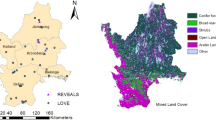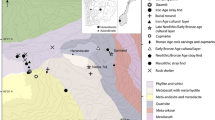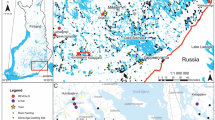Abstract
Quantitative pollen-based land-cover reconstruction covering the last 4,000 years was performed using transformation coefficients derived from a modern pollen land-cover database and a palynological record from an annually laminated sequence in Lake Rõuge Tõugjärv. Proportions of four land-cover classes characteristic of cultural landscape were reconstructed: habitation area, arable land, grassland and woodland. A land-use change model using CA_Markov analysis was applied for spatial reconstructions for seven periods: 600 b.c., a.d. 300, 800, 1200, 1700, 1870 and 1940. Historical maps from a.d. 1684, 1870–1899 and 1935 were used for calibration of quantitative estimates and to validate spatial reconstructions. The accuracy of the estimates depends on the availability of modern analogues and differs among land-cover classes, being highest for classes with directly connectable pollen indicator types (arable land, forest) and lowest for settlement areas. Spatial reconstructions produced by the CA_Markov land-cover change model show moderate accordance with historical data. However, the large uncertainties in land-cover input data must be considered in the evaluation of the KIA results of the spatial model. Permanent low intensity, rural land-use in the Rõuge area started at the beginning of the Bronze Age (c. 1800 b.c.). The major increase in the extent of rural land-use took place at the beginning of the 13th century and culminated during the 19th century when c. 90% of the RSAP of Rõuge Tõugjärv was open. During the last century, rural land-use decreased constantly.







Similar content being viewed by others
References
Behre KE (1981) The interpretation of anthropogenic indicators in pollen diagrams. Pollen Spores 23:225–245
Berglund BE (ed) (1991) The cultural landscape during 6,000 years in southern Sweden—the Ystad project. Ecological Bulletins 41, Munksgaard, Copenhagen
Berglund BE, Ralska-Jasiewiczowa M (1986) Pollenanalysis and pollendiagrams. In: Berglund BE (ed) Handbook of Holocene palaeoecology and palaeohydrolology. Wiley, Chichester, pp 455–484
Broström A, Sugita S, Gaillard M-J (2004) Pollen productivity estimates for reconstruction of past vegetation cover in the cultural landscape of Southern Sweden. Holocene 14:371–384
Broström A, Sugita S, Gaillard M-J, Pilesjö P (2005) Estimating spatial scale of pollen dispersal in the cultural landscape of southern Sweden. Holocene 15:1–14
Bunting MJ (2003) Pollen-based reconstruction of cultural landscapes: an investigation of pollen source area for non-arboreal taxa. Rev Palaeobot Palynol 125:285–298
Bunting MJ, Gaillard MJ, Sugita S, Middleton R, Broström A (2004) Vegetation structure and pollen source area. Holocene 14:651–660
Cousins SAO (2001) Analysis of land-cover transitions based on 17th and 18th century cadastral maps and aerial photographs. Landsc Ecol 16:41–54
Davis MB (2000) Palynology after Y2K—understanding the source area of pollen in sediments. Ann Rev Earth Planet Sci 28:1–18
D’Souza VL (1970) Investigations concerning the suitability of wheat as pollen-donor for cross-pollination by wind compared to rye, Triticale, and Secalotricum. Z Pflanzenzücht. 63:246–269
Foster DR, Hall B, Barry S, Clayden S, Parshall T (2002) Cultural, environmental and historical controls of vegetation patterns and the modern conservation setting on the island of Martha’s Vineyard, USA. J Biogeogr 29:1381–1400
Fuller JL, Foster DR, McLachlan JS, Drake N (1998) Impact of human activity on regional forest composition and dynamics in central New England. Ecosystems 1:76–95
Fyfe RM (2006) GIS and the application of a model of pollen deposition and dispersal: a new approach to testing landscape hypotheses using the POLLANDCAL models. J Archaeol Sci 33:483–493
Gaillard M-J, Birks HJB, Emanuelsson U, Berglund BE (1992) Modern pollen/land-use relationships as an aid in reconstruction of past land-uses and cultural landscapes: Example from south Sweden. Veget Hist Archaeobot 1:3–17
Goslar T, Ralska-Jasiewiczowa M, Geel B van, Łacka B, Szeroczynska K, Chrost L, Walanus A (1999) Anthropogenic changes in the sediment composition of Lake Gosciaz (central Poland), during the last 330 yrs. J Paleolimnol 22:171–185
Grimm EC (1991) TILIA and Tilia graph. Illinois State Museum, Springfield
Irwin EG, Geoghegan J (2001) Theory, data, methods: developing spatially explicit economic models of land use change. Agric Ecosyst Environ 85:7–23
Iversen J (1941) Land occupation in Danmark’s Stone Age. Danmarks Geol Unders, Ser 2. 66:1–65
Jaanits L, Laul S, Lõugas V, Tõnisson E (1982) Eesti esiajalugu (Estonian prehistory). Valgus, Tallinn
Joosten JHJ (1985) A 130 year micro- and macrofossil record from regeneration peat in the Peel, The Netherlands: a palaeoecological study with agricultural and climatological implications. Palaeogeogr Palaeoclimatol Palaeoecol 49:277–312
Kask R (1996) Eesti mullad (Estonian soils). Mats, Tallinn
Konsa M (1999) Geograafilise infosüsteemi kasutamine arheoloogias Rõuge kihelkonna näitel (The application of geographic information systems in archaeology on the example of Rõuge parish). Peaseminaritöö, Tartu University, Tartu
Koppel K (2005) Maakasutuse uurimise metoodika Kasaritsa uurimisala (Rõuge kihelkond) 17–19. sajandi külamaastike kujunemise näitel [The research methods of historical land use as exemplified by the formation of rural landscapes on Kasaritsa study area (Rõuge parish) in 17th–19th centuries. Msc thesis, Tartu University, Tartu
Lang V (1999) The introduction and early history of farming in Estonia, as revealed by archaeological material. In: Miller U, Hackens T, Lang V, Raukas A, Hicks S (eds) Environmental and cultural history of the Eastern Baltic Region, vol 57. PACT, Rixensart, pp 325–338
Lang V, Kriiska A (2001) Eesti esiaja periodiseering ja kronoloogia (Periodisation and chronology of Estonian prehistory). Eesti Arheoloogia Ajakiri 5(2):83–109
Lotter AF, Appleby PG, Bindler R, Dearing JA, Grytnes JA, Hofmann W, Kamenik C, Lami A, Livingstone DM, Ohlendorf C, Rose N, Sturm M (2002). The sediment record of the past 200 years in a Swiss high-alpine lake: Hagelseewli (2339 m a.s.l.). J Paleolimnol 28:111–127
Nielsen AB (2003) Pollen based quantitative estimation of land cover—relationships between pollen sedimentation in lakes and land cover as seen on historical maps in Denmark ad 1800. Ph.D. thesis, Univ Copenhagen and Geol Surv Denm Greenl. Danmarks og Grønlands geologiske undersøgelse rapport 57
Nielsen AB, Odgaard BV (2004) The use of historical analogues for interpreting fossil pollen records. Veget Hist Archaeobot 13:33–43
Niinemets E, Saarse L (2006) Holocene forest dynamics and human impact in southeastern Estonia. Veget Hist Archaeobot 16:1–13
Niinemets E, Saarse L (2007) Fine-resolution pollen-based evidences of farming and forest development, southeastern Estonia. Pol J Ecol (in press)
Odgaard BV, Rasmussen P (2000) Origin and temporal development of macro-scale vegetation patterns in the cultural landscape of Denmark. J Ecol 88:733–748
Petit CC, Lambin EF (2002) Impact of data integration technique on historical land-use/land-cover change: comparing historical maps with remote sensing data in the Belgian Ardennes. Landsc Ecol 17:117–132
Pontius GR, Malanson J (2005) Comparison of the structure and accuracy of two land change models. Int J Geogr Inf Sci 19:243–265
Poska A (2001) Human impact on vegetation of Coastal Estonia during the Stone Age. Acta Universitatis Upsaliensis, Uppsala, pp 1–48
Poska A, Saarse L (1999) Holocene vegetation and land-use history in the environs of Lake Kahala, northern Estonia. Veget Hist Archaeobot 8:185–197
Poska A, Saarse L, Veski S (2004) Reflections of pre- and early-agrarian human impact in the pollen diagrams of Estonia. Palaeogeogr Palaeoclimatol Palaeoecol 209:37–50
Rebane H (1941) Liivimaa 1638. a. maarevisjon Eesti asustusalaI. Kaguosa [Land revision of Livland in 1638]. ENSV Riigi Keskarhiivi Tartu osakonna toimetused 1:195–200
Remm K (1999) Reeglipärasusi Otepää kõrgustiku maastikumustris Eesti põhikaardi lehe 5434 näitel [Regular patterns in landscape of Otepää Heights, example from page 5434 of the Estonian cadastrial map. Msc thesis, Tartu University, Tartu
Roslavlev O (1965) Das Dorpater Land 1624/27. Hefte zur Landeskunde Estlands. Wolfratshausen-Waldram, München
Rumma J, Tammekann A, Veski JV (1926) Võrumaa. Maateaduslik, tulunduslik ja ajalooline kirjeldus, Eesti 2. Eesti Kirjanduse Selts, Tartu
Saaty TL (2003) Decision-making with AHP: Why is the principal eigenvector necessary. Eur J Oper Res 145:85–91
Sarmaja-Korjonen K (1992) Fine-interval pollen and charcoal analyses as tracers of early clearance periods in S Finland. Acta Bot Fenn 146:1–75
Sugita S (1994) Pollen representation of vegetation in Quaternary sediments: theory and method in patchy vegetation. J Ecol 82:881–897
Sugita S, Gaillard M-J, Broström A (1999) Landscape openness and pollen records: a simulation approach. Holocene 9:409–421
Veski S, Lang V (1996) Prehistoric human impact in the vicinity of Lake Maardu, Northern Estona. A synthesis of pollen analytical and archaeological results. In: Hackens T, Hicks S, Lang V, Miller U, Saarse L (eds) Coastal Estonia. Recent advances in environmental and cultural history, vol 51. PACT, Rixensart, pp 189–204
Veski S, Koppel K, Poska A (2005) Integrated palaeoecological and historical data in the service of fine-resolution land use and ecological change assessment during the last 1000 years in Rõuge, S Estonia. J Biogeogr 32:1473–1488
von Neumann J (1966) Theory of self-reproducing automata. University of Illinois Press, Urbana, IL
Zillén L, Snowball I, Sandgren P, Stanton T (2003) Occurrence of varved lake sediment sequences in Värmland, west central Sweden: lake characteristics, varve chronology and AMS radiocarbon dating. Boreas 32:612–626
Acknowledgments
We thank the POLLANDCAL group for informative discussions. We are grateful to Raivo Aunap and Agu Vissel for vectorisation of the topographic model of the area and to Dr. Ralph Fyfe and Dr. Robert Szava-Kovats for linguistic revision. Prof. B. Berglund and an anonymous referee are thanked for their constructive and useful comments. Financial support was provided by Estonian target funding projects 0182530s03, 0331758s01 and 0332626s03 and the Estonian Science Foundation (grants 6736, 6995 and 5923).
This is a contribution to the NordForsk funded network POLLANDCAL (http://www.geog.ucl.ac.uk/ecrc/pollandcal/).
Author information
Authors and Affiliations
Corresponding author
Additional information
Communicated by M.-J. Gaillard.
Rights and permissions
About this article
Cite this article
Poska, A., Sepp, E., Veski, S. et al. Using quantitative pollen-based land-cover estimations and a spatial CA_Markov model to reconstruct the development of cultural landscape at Rõuge, South Estonia. Veget Hist Archaeobot 17, 527–541 (2008). https://doi.org/10.1007/s00334-007-0124-8
Received:
Accepted:
Published:
Issue Date:
DOI: https://doi.org/10.1007/s00334-007-0124-8




